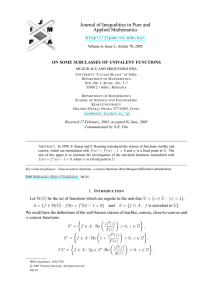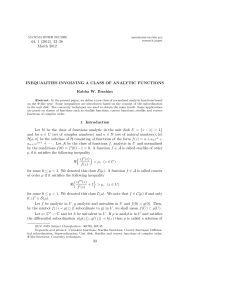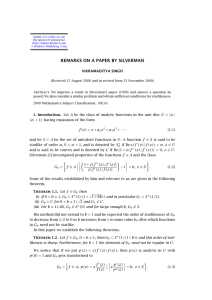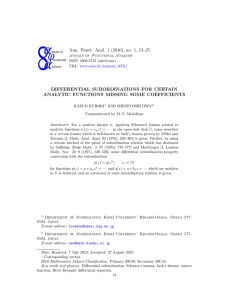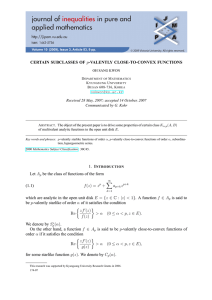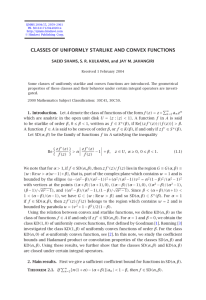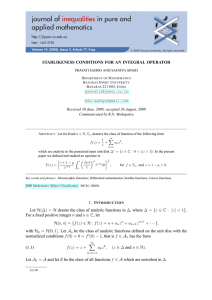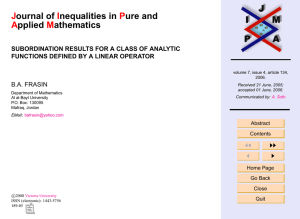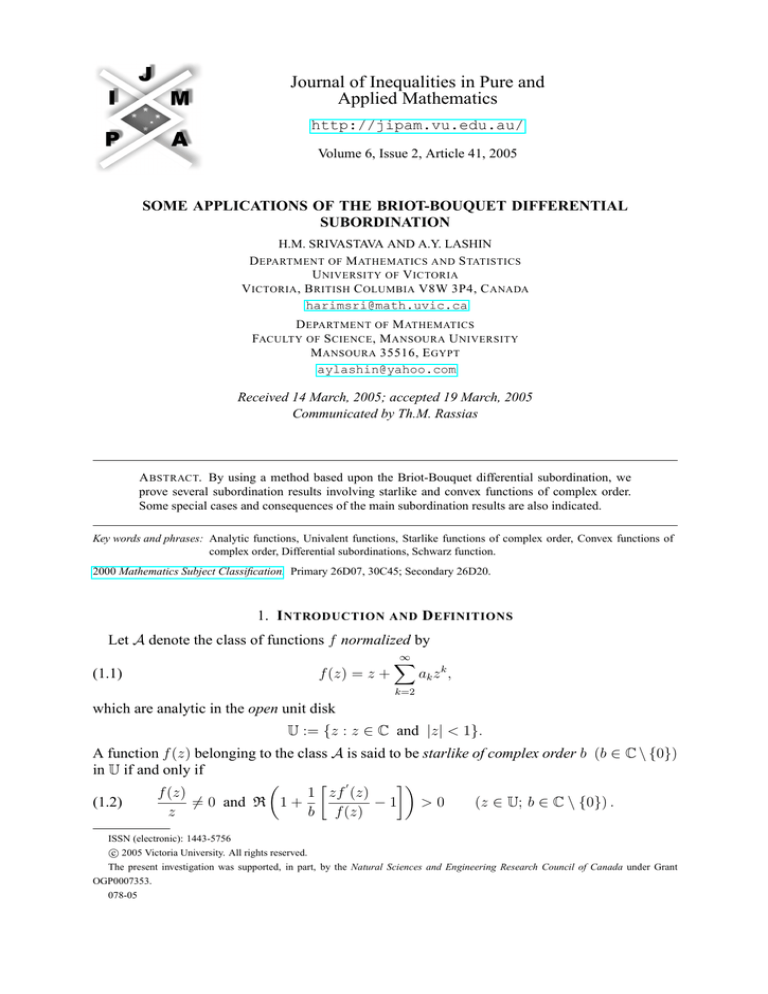
Journal of Inequalities in Pure and
Applied Mathematics
http://jipam.vu.edu.au/
Volume 6, Issue 2, Article 41, 2005
SOME APPLICATIONS OF THE BRIOT-BOUQUET DIFFERENTIAL
SUBORDINATION
H.M. SRIVASTAVA AND A.Y. LASHIN
D EPARTMENT OF M ATHEMATICS AND S TATISTICS
U NIVERSITY OF V ICTORIA
V ICTORIA , B RITISH C OLUMBIA V8W 3P4, C ANADA
harimsri@math.uvic.ca
D EPARTMENT OF M ATHEMATICS
FACULTY OF S CIENCE , M ANSOURA U NIVERSITY
M ANSOURA 35516, E GYPT
aylashin@yahoo.com
Received 14 March, 2005; accepted 19 March, 2005
Communicated by Th.M. Rassias
A BSTRACT. By using a method based upon the Briot-Bouquet differential subordination, we
prove several subordination results involving starlike and convex functions of complex order.
Some special cases and consequences of the main subordination results are also indicated.
Key words and phrases: Analytic functions, Univalent functions, Starlike functions of complex order, Convex functions of
complex order, Differential subordinations, Schwarz function.
2000 Mathematics Subject Classification. Primary 26D07, 30C45; Secondary 26D20.
1. I NTRODUCTION AND D EFINITIONS
Let A denote the class of functions f normalized by
∞
X
(1.1)
f (z) = z +
ak z k ,
k=2
which are analytic in the open unit disk
U := {z : z ∈ C and |z| < 1}.
A function f (z) belonging to the class A is said to be starlike of complex order b (b ∈ C \ {0})
in U if and only if
0
f (z)
1 zf (z)
(1.2)
6= 0 and R 1 +
−1
>0
(z ∈ U; b ∈ C \ {0}) .
z
b f (z)
ISSN (electronic): 1443-5756
c 2005 Victoria University. All rights reserved.
The present investigation was supported, in part, by the Natural Sciences and Engineering Research Council of Canada under Grant
OGP0007353.
078-05
2
H.M. S RIVASTAVA AND A.Y. L ASHIN
We denote by S0∗ (b) the subclass of A consisting of functions which are starlike of complex
order b in U. Further, let S1∗ (b) denote the class of functions f ∈ A satisfying the following
inequality:
0
zf (z)
< |b| (z ∈ U; b ∈ C \ {0}).
(1.3)
−
1
f (z)
We note that S1∗ (b) is a subclass of S0∗ (b).
A function f (z) belonging to the class A is said to be convex of complex order b (b ∈ C\{0})
in U if and only if
f (z)
1 zf 00 (z)
(1.4)
6= 0 and R 1 +
>0
(z ∈ U; b ∈ C \ {0}) .
z
b f 0 (z)
We denote by K0 (b) the subclass of A consisting of functions which are convex of complex
order b in U. Furthermore, let K1 (b) denote the class of functions f ∈ A satisfying the following
inequality:
00 zf (z) 0
(1.5)
f (z) < |b| (z ∈ U; b ∈ C \ {0}),
so that, obviously, K1∗ (b) is a subclass of K0∗ (b).
We note that
(1.6)
0
f (z) ∈ K0 (b) ⇔ zf (z) ∈ S0∗ (b)
(b ∈ C \ {0})
and
(1.7)
0
f (z) ∈ K1 (b) ⇔ zf (z) ∈ S1∗ (b)
(b ∈ C \ {0}).
The classes S0∗ (b) and K0 (b) of starlike and convex functions of a complex order b in U were
introduced and investigated earlier by Nasr and Aouf [8] and Wiatrowski [12], respectively (see
also [6], [7] and [9]). Their subclasses S1∗ (b) and K1 (b) were studied by (among others) Choi
[1] (see also Choi and Saigo [2]), Polatoǧlu and Bolcal [10] and Lashin [4].
Remark 1. Upon setting b = 1 − α (0 5 α < 1), we observe that
S0∗ (1 − α) = S ∗ (α) and K0 (1 − α) = K(α),
where S ∗ (α) and K(α) denote, respectively, the relatively more familiar classes of starlike and
convex functions of a real order α in U (see, for example, [11]).
Finally, for two functions f and g analytic in U, we say that the function f (z) is subordinate
to g (z) in U, and write
f ≺g
or
f (z) ≺ g (z)
(z ∈ U) ,
if there exists a Schwarz function w (z), analytic in U with
w(0) = 0 and |w(z)| < 1
(z ∈ U),
such that
(1.8)
f (z) = g w (z)
(z ∈ U) .
In particular, if the function g is univalent in U, the above subordination is equivalent to
(1.9)
f (0) = g(0)
and f (U) ⊂ g(U).
The main object of the present sequel to the aforementioned works is to apply a method based
upon the Briot-Bouquet differential subordination in order to derive several
subordination results involving starlike and convex functions of complex order. We also
indicate some interesting special cases and consequences of our main subordination results.
J. Inequal. Pure and Appl. Math., 6(2) Art. 41, 2005
http://jipam.vu.edu.au/
S OME A PPLICATIONS OF THE B RIOT-B OUQUET D IFFERENTIAL S UBORDINATION
3
2. M AIN S UBORDINATION R ESULTS
In order to prove our main subordination results, we shall make use of the following known
results.
Lemma 1 (cf. Miller and Mocanu [5, p. 17 et seq.]). Let the functions F (z) and G(z) be
analytic in the open unit disk U and let
F (0) = G(0).
If the function H(z) := zG0 (z) is starlike in U and
zF 0 (z) ≺ zG0 (z)
(z ∈ U),
then
Z
z
H(t)
dt
(z ∈ U).
t
0
The function G(z) is convex and is the best dominant in (2.1).
(2.1)
F (z) ≺ G(z) = G(0) +
Lemma 2 (Eenigenburg et al. [3]). Let β and γ be complex constants. Also let the function
h(z) be convex (univalent) in U with
h(0) = 1 and R βh(z) + γ > 0
(z ∈ U).
Suppose that the function
p(z) = 1 + p1 z + p2 z 2 + p3 z 3 + · · ·
is analytic in U and satisfies the following differential subordination:
zp0 (z)
(2.2)
p(z) +
≺ h(z)
(z ∈ U).
βp(z) + γ
If the differential equation:
zq 0 (z)
(2.3)
q(z) +
= h(z)
q(0) := 1
βq(z) + γ
has a univalent solution q(z), then
p(z) ≺ q(z) ≺ h(z)
(z ∈ U)
and q(z) is the best dominant in (2.2) that is, p(z) ≺ q(z) (z ∈ U) for all p(z) satisfying
(2.2) and if p(z) ≺ q̂(z) (z ∈ U) for all p(z) satisfying (2.2), then q(z) ≺ q̂(z) (z ∈ U).
Remark 2. The conclusion of Lemma 2 can be written in the following form:
zp0 (z)
zq 0 (z)
p(z) +
≺ q(z) +
⇒ p(z) ≺ q(z)
(z ∈ U).
βp(z) + γ
βq(z) + γ
Remark 3. The differential equation (2.3) has its formal solution given by
β
zF 0 (z)
β + γ H(z)
γ
q(z) =
=
− ,
F (z)
β
F (z)
β
where
β1
Z
β+γ z
β γ−1
F (z) =
{H(t)} t
dt
zγ
0
and
Z z
h(t) − 1
H(z) = z · exp
dt .
t
0
J. Inequal. Pure and Appl. Math., 6(2) Art. 41, 2005
http://jipam.vu.edu.au/
4
H.M. S RIVASTAVA AND A.Y. L ASHIN
We now state our first subordination result given by Theorem 1 below.
Theorem 1. Let the function h(z) be convex (univalent) in U and let
h(0) = 1 and R bh(z) + (1 − b) > 0
(z ∈ U).
Also let f (z) ∈ A.
(a) If
1 zf 00 (z)
≺ h(z)
b f 0 (z)
1+
(2.4)
(z ∈ U),
then
(2.5)
1
1+
b
zf 0 (z)
− 1 ≺ h(z)
f (z)
(z ∈ U).
(b) If the following differential equation:
zq 0 (z)
q(z) +
= h(z) q(0) := 1
βq(z) + γ
has a univalent solution q(z), then
1 zf 00 (z)
1 zf 0 (z)
(2.6)
1+
≺ h(z) ⇒ 1 +
− 1 ≺ q(z) ≺ h(z)
b f 0 (z)
b
f (z)
(z ∈ U)
and q(z) is the best dominant in (2.6).
Proof. We begin by setting
(2.7)
1
1+
b
zf 0 (z)
− 1 =: p(z),
f (z)
so that p(z) has the following series expansion:
p(z) = 1 + p1 z + p2 z 2 + p3 z 3 + · · · .
By differentiating (2.7) logarithmically, we obtain
zp0 (z)
1 zf 00 (z)
p(z) +
=1+
bp(z) + (1 − b)
b f 0 (z)
and the subordination (2.4) can be written as follows:
zp0 (z)
p(z) +
≺ h(z)
(z ∈ U).
bp(z) + (1 − b)
Now the conclusions of the theorem would follow from Lemma 2 by taking
β=b
γ = 1 − b.
and
This evidently completes the proof of Theorem 1.
Next we prove Theorem 2 below.
Theorem 2. If f (z) ∈ K1 (b) (|b| 5 1; b 6= 0), then
1 zf 0 (z)
1+
− 1 ≺ q(z)
b
f (z)
(z ∈ U),
where q(z) is the best dominant given by
(2.8)
q(z) = 1 −
J. Inequal. Pure and Appl. Math., 6(2) Art. 41, 2005
1
zebz
+ bz
.
b e −1
http://jipam.vu.edu.au/
S OME A PPLICATIONS OF THE B RIOT-B OUQUET D IFFERENTIAL S UBORDINATION
5
Proof. First of all, we observe that (1.5) is equivalent to the following inequality:
00
zf
(z)
1
1+
<1
−
1
(z ∈ U),
b f 0 (z)
which implies that
1+
1 zf 00 (z)
≺1+z
b f 0 (z)
(z ∈ U).
Thus, in Theorem 1, we choose
h(z) = 1 + z
and note that
R bh(z) + (1 − b) > 0 when z ∈ U and |b| 5 1 (b 6= 0),
and h(z) satisfies the hypotheses of Lemma 2. Consequently, in the view of Lemma 2 and
Remark 3, we have
Z z
h(t) − 1
H(z) = z · exp
dt
t
0
which, for h(t) = 1 + t, yields
H(z) = zez
(2.9)
and
F (z) =
1
Z
z 1−b
z
0
H(t)
t
b
! 1b
dt
,
that is,
F (z) =
1
Z
z
1b
e dt ,
bt
z 1−b 0
which readily simplifies to the following form:
1
b
1
bz
(2.10)
F (z) =
e −1
,
bz 1−b
From (2.9) and (2.10), we obtain
b
1 H(z)
1−b
q(z) =
−
,
b F (z)
b
which leads us easily to (2.8), thereby completing our proof of Theorem 2.
Lastly, we prove the following subordination result.
Theorem 3. Let f (z) ∈ S0∗ (b) (b ∈ C \ {0}), then
(2.11)
f (z)
1
≺
z
(1 − z)2b
(z ∈ U)
and this is the best dominant.
Proof. Since f (z) ∈ S0∗ (b) (b ∈ \{0}), we have
1 zf 0 (z)
1+z
1+
−1 ≺
b
f (z)
1−z
that is,
1 zf 0 (z)
2z
2
(2.12)
+1 ≺
+
b
f (z)
1−z b
J. Inequal. Pure and Appl. Math., 6(2) Art. 41, 2005
(z ∈ U),
(z ∈ U).
http://jipam.vu.edu.au/
6
H.M. S RIVASTAVA AND A.Y. L ASHIN
Now, by setting
1
P (z) := zf (z) b
(z ∈ U),
we can rewrite (2.12) in the following form:
h 2
i0
0
z log P (z) ≺ z log z b (1 − z)−2
(z ∈ U).
Thus, by setting
i
h 2
F (z) = log P (z) and G(z) = log z b (1 − z)−2
in Lemma 1, we find that
i
h 2
log P (z) ≺ log z b (1 − z)−2
(z ∈ U),
which obviously is equivalent to the assertion (2.11) of Theorem 3.
3. S OME I NTERESTING D EDUCTIONS
In view especially of the equivalence relationships exhibited by (1.6) and (1.7), each of our
main results proven in the preceding section can indeed be applied to yield the corresponding
subordination results involving convex functions of order b ∈ C \ {0}. For example, Theorem
3 would immediately lead us to the following subordination result.
Corollary 1. Let f (z) ∈ K0 (b) (b ∈ C \ {0}). Then
1
f 0 (z) ≺
(z ∈ U)
(1 − z)2b
and this is the best dominant.
R EFERENCES
[1] J.H. CHOI, Starlike and convex function of complex order involving a certain fractional integral
operator, in New Developments in Convolution (Japanese) (Kyoto, 1997), Sūrikaisekikenkyūsho
Kōkyūroku, 1012 (1997), 1–13.
[2] J.H. CHOI AND M. SAIGO, Starlike and convex functions involving a certain fractional integral
operator, Fukuoka Univ. Sci. Rep., 28(2) (1998), 29–40.
[3] P. EENIGENBURG, S.S. MILLER, P.T. MOCANU AND M.O. READ, On a Briot-Bouquet
differential subordination, in General Inequalities 3, pp. 339–348, International Series of
Numerical Mathematics, Vol. 64, Birkhäuser Verlag, Basel, 1983; see also Rev. Roumaine Math.
Pures Appl., 29 (1984), 567–573.
[4] A.Y. LASHIN, Starlike and convex functions of complex order involving a certain linear operator,
Indian J. Pure Appl. Math., 34 (2003), 1101–1108.
[5] S.S. MILLER AND P.T. MOCANU, Differential Subordinations: Theory and Applications, Series
on Monographs and Textbooks in Pure and Applied Mathematics (No. 225), Marcel Dekker, New
York and Basel, 2000.
[6] G. MURUGUSUNDARAMOORTHY AND H.M. SRIVASTAVA, Neighborhoods of certain classes
of analytic functions of complex order, J. Inequal. Pure Appl. Math., 5(2) (2004), Art. 24, pp. 1-8.
[ONLINE: http://jipam.vu.edu.au/article.php?sid=374]
[7] M.A. NASR AND M.K. AOUF, On convex functions of complex order, Mansoura Sci. Bull. Egypt,
9 (1982), 565–582.
[8] M.A. NASR AND M.K. AOUF, Starlike function of complex order, J. Natur. Sci. Math., 25 (1985),
1–12.
J. Inequal. Pure and Appl. Math., 6(2) Art. 41, 2005
http://jipam.vu.edu.au/
S OME A PPLICATIONS OF THE B RIOT-B OUQUET D IFFERENTIAL S UBORDINATION
7
[9] S. OWA AND G.S. SǍLǍGEAN, On an open problem of S. Owa, in New Developments in
Convolution (Japanese) (Kyoto, 1997), Sūrikaisekikenkyūsho Kōkyūroku 1012 (1997), 110–114;
see also J. Math. Anal. Appl., 218 (1998), 453–457.
[10] Y. POLATOǦLU AND M. BOLCAL, The radius of convexity for the class of Janowski convex
functions of complex order, Mat. Vesnik, 54 (2002), 9–12.
[11] H.M. SRIVASTAVA AND S. OWA (Editors), Current Topics in Analytic Function Theory, World
Scientific Publishing Company, Singapore, New Jersey, London and Hong Kong, 1992.
[12] P. WIATROWSKI, On the coefficients of some family of holomorphic functions, Zeszyty Nauk.
Uniw. Łódz Nauk. Mat.-Przyrod. (Ser. 2), 39 (1970), 75–85.
J. Inequal. Pure and Appl. Math., 6(2) Art. 41, 2005
http://jipam.vu.edu.au/

